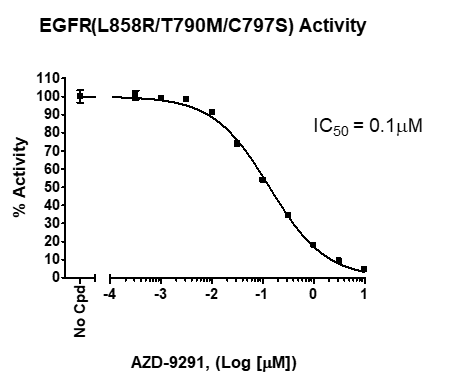EGFR (T790M/C797S/ L858R) Kinase Assay Kit
The epidermal growth factor receptor (EGFR; ErbB-1; HER1) is the cellsurface receptor for members of the epidermal growth factor family. Overexpression and/or hyperactivation of EGFR kinase is associated with several human cancers such as lung, glioblastoma, and epithelian tumors of the neck and head, leading to the development of anticancer therapeutics targeting EGFR. T790M, L858R and C797S mutations in EGFR cause resistance to known EGFR inhibitors. The EGFR(T790M/C797S/L858R) Kinase Assay Kit is designed to identify mutant-selective EGFR kinase inhibitors and to measure EGFR (T790M/C797S/L858R) kinase activity for screening and profiling applications using Kinase-Glo® MAX as a detection reagent.
Need us to run inhibitor screens or profile your compounds against EGFR (T790M/C797S/ L858R)? Check out our Kinase Screening Services.
- Kinase-Glo MAX (Promega #V6071)
- Dithiothreitol (DTT, 1 M; optional)
- Microplate reader capable of reading luminescence
- Adjustable micropipettor and sterile tips
- 30°C incubator
| Catalog Number |
Reagent |
Amount |
Storage |
|
| 40351 | EGFR (T790M/C797S/L858R) | 2 µg | -80°C | Avoid multiple freeze/ thaw cycles! |
| 79334 | 5x Kinase assay buffer | 1.5 ml | -20°C | |
| 79686 | ATP (500 μM) | 100 µl | -20°C | |
| 40217 | PTK substrate Poly (Glu:Tyr 4:1) (10 mg/ml) | 100 µl | -20°C | |
| 79696 | 96-well plate, white | 1 | Room Temp. | |
Wang, S., et al. J. Hematology & Oncology 9:59 (2016)
Jia, Y., et al. Nature 534(7605): 129–132 (2016).


